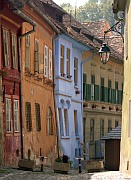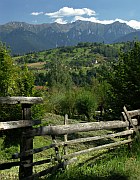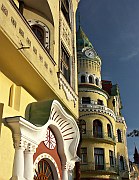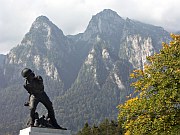This website is an archive from 2016
This site was actively maintained from 2006 to 2016. Since then I have kept it online for historical interest, but have made no further updates. Much of the information in these pages is now incorrect or obsolete.
Romania | Introduction
Romania is by far the largest country in the Balkans, so it's no surprise that it contains a diverse range of landscapes and cultures. Although it's not as uniformly mountainous as several other Balkan countries, the beautiful Carpathian mountains cut right through the heart of the country and are an important part of its identity. The province of Transylvania, north and west of these mountains, is historically not part of the Balkans at all.
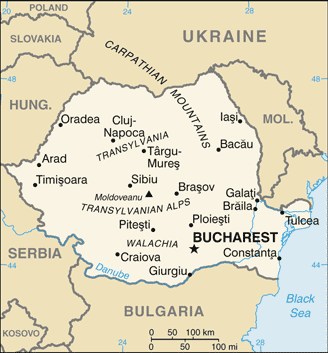

Where to go: some suggestions
Transylvania offers the opportunity for a varied holiday, with many places of interest in a fairly small area. The cities of Braşov and Sibiu and the smaller town of Sighişoara have many treasures of mediaeval architecture and reminders of the strong German influence in the region, while the lively university town of Cluj is also worth a visit. Sibiu and Cluj both have outdoor museums of rural architecture. But Transylvania is not just about towns: they are surrounded by rolling green hills and picturesque villages, some with fortified churches, the most original architectural features of the region. Braşov is a particularly good base, with easy access to a variety of castles, villages, and fortified churches. Just over the provincial border in Wallachia you can visit Sinaia's Peleş Castle, an imposing if slightly bizarre 19th century palace.
The wooded valleys of Southern Bucovina, near Romania's northern border, shelter a group of artistic masterpieces that seem to belong to a different world from Transylvania's Gothic churches. I've visited many Orthodox monasteries all over the Balkans, and found the Painted Monasteries the most moving of all. Also in the northeast is the city of Iaşi, some way off the usual tourist beat but perhaps unfairly overlooked. Admittedly it's a bit of an architectural mess, but I think it's a fascinating one - you're never quite sure what you are going to come across while wandering its streets.

Romania's mountains provide many opportunities for hiking, from short walks to serious treks. Popular hiking areas have well-marked trails and plenty of cabanas. The Bucegi Mountains and Prahova Valley, south of Braşov, are particularly accessible, but there are many other possibilities.
Bucharest receives mixed reviews from travellers. Its detractors point to its lack of old buildings, traffic fumes, litter, brutalist modern architecture, and general falling-apartness. It's true that you are likely to be disappointed if you go there expecting a postcard-pretty Central European city like Prague or Krakow. But there is plenty to discover here: monasteries overlooked by skyscrapers, museums, parks. And of course there is the gargantuan Palace of Parliament, one of Europe's most vivid symbols of dictatorial power. Almost as striking as the building itself are the vast empty spaces around it, once the location of the city's oldest buildings, now overgrown with grass.
Western Romania offers yet more variety. Fans of curvy Art Nouveau architecture should head for Oradea, while Timişoara will appeal to admirers of Hapsburg elegance. Near the latter is Băile Herculane, a gently decaying spa town surrounded by beautiful countryside.
Romania is much larger than the other countries in the Balkan region - twice the size of Bulgaria and about the same as the United Kingdom - and I have only scratched the surface in my explorations so far. In particular I haven't yet visited two major attractions at opposite ends of the country. Maramureş in the northwest is said to be the best example of traditional rural life, while the Danube delta is an important wildlife reserve.
You may be wondering if I am really going to write an introduction to Romania without mentioning Dracula. Well, I am. There are already far too many stories about Romania as the Land of Dracula, usually involving cringe-inducing metaphors and corny jokes. I have therefore buried Dracula in the FAQ. With a stake through his heart.
Practicalities
Transport
Romania is the one Balkan country in which it makes sense to travel mainly by train. Although the network is less dense than in most of Central Europe, it does go to most places, albeit not always very quickly. Travelling by train requires a certain amount of patience. Timetables often seem to be designed to make sure that if there are ten train a day nine of them will pass by in the middle of the night. Much of the rolling stock is not exactly state of the art, and the system can appear rather complicated at first - for more details see the FAQ. Despite all this I warmly recommend train travel in Romania - it is very much part of Romanian life, timekeeping is usually reliable, and it is a great way to get a feel for the country while enjoying views of its varied landscape.

There is another reason for recommending train travel: the Romanian bus system is, frankly, a bit of a mess. Many cities have several bus stations, generally quite run-down, like the buses themselves. In contrast to Bulgaria, there don't seem to be many private companies running comfortable long-distance coaches. Instead there are maxitaxis, known to the rest of the world as minibuses; these can get very cramped. I vividly remember a maxitaxi journey from Suceava to Braşov: some passengers had to sit on crates in the aisle, hanging on for dear life as the driver slalomed from one side of the road to the other to avoid crater-like potholes, ambling pedestrians, and horses and carts. Still, bus travel can work out fine for short trips such as Braşov to Bran.
Romania has good international train connections to Hungary - from Budapest it is possible to choose from a variety of routes into Romania depending on where you want to see. Connections to all of Romania's other neighbouring countries are limited to one or two trains a day; in some cases these are supplemented by buses and maxitaxis.
Money
The Romanian currency is the leu, plural lei. Until quite recently Romania had the least valuable nominal currency unit in Europe, so that it was easy to become an instant lei millionaire with a single trip to an ATM. In 2005 four zeroes were knocked off the end to create the new leu (RON). Both old and new coins and banknotes will be in circulation until December 31, 2006, when the old currency will be withdrawn. Old and new Romanian banknotes are far more attractive than bland Euronotes, printed in bright, easily distinguished colours and made of hard-wearing plastic. Romania is generally a fairly cheap country, although possibly more expensive than Bulgaria.

Language
Romanian is probably the most approachable Balkan language for most Western Europeans. Its Latin roots give it a much more familiar appearance than Greek or the various Slavic languages. Like most Orthodox countries Romania used the Cyrillic script until the 19th century, but the language is now always written in the Latin alphabet. If you can read any Romance language you should be able to make a fair guess at the meaning of written Romanian, although you may notice quite a few unfamiliar words derived from Slavic and other languages. There is a substantial Hungarian-speaking minority in Transylvania. As in much of Eastern Europe the number of people who speak English is increasing, but it's still a relatively small proportion of the population. My rusty school French helped me out on several occasions in Romania - France has traditionally had a significant cultural influence and it's not unusual to find older people who speak French.
The Roman province of Dacia was only about half the size of modern Romania, and Roman rule there lasted less than two centuries. Nevertheless it's common to see reminders of Roman heritage in modern Romania, such as the monument to Romulus and Remus in Timişoara. The Palace of Culture in Iaşi, far beyond the boundaries of the Empire, bears the inscription SPQR, just like ancient temples (and modern manhole covers) in Rome itself.
